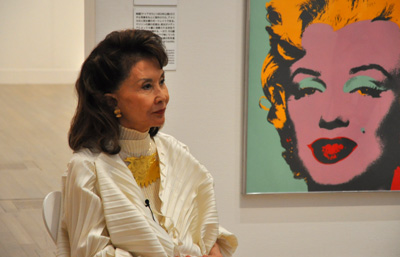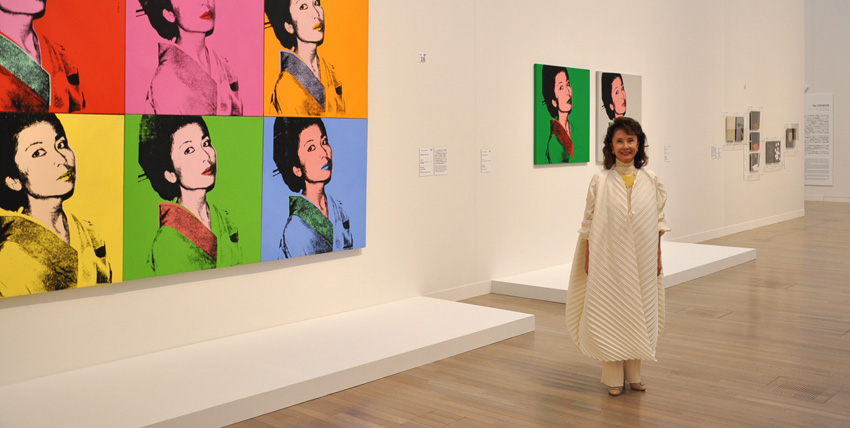What do you think of when you hear the term “Pop Art”? Probably the first image that comes to mind is one of Roy Lichtenstein’s cartoon-strip paintings or Andy Warhol’s portraits of Marilyn Monroe. But did you know that Andy Warhol also created multiple portraits of a Japanese woman? These screenprints of an elegant Japanese woman in a kimono are rendered in the vibrant colors characteristic of Warhol’s work. But who is that mysterious beauty he chose as his subject? It’s Kimiko Powers, who with her late husband John amassed one of the most comprehensive collections of Pop Art in private hands. She was in Tokyo for the opening of “American Pop Art: From the John and Kimiko Powers Collection” at the National Art Center, Tokyo in Roppongi, and “American View” had an opportunity to speak with her there.
Connections between Artist and Collector

“He created portraits of Marilyn Monroe and other famous and beautiful women, like Jacqueline Kennedy and Liz Taylor,” explained Kimiko. “Apparently he was becoming increasingly interested in doing portraits of regular people as well and hoped to become a portrait artist some day. Well, I just happened to be close at hand when he started out.” Despite Kimiko’s modesty, there’s no doubt that Warhol sought her out as a subject, because he apparently asked her if he could do a portrait of her each time she changed her hairstyle! And meeting her, it’s easy to understand why. She walked into the gallery for our appointment looking dreamy in a billowy white tunic by Issey Miyake and a stunning limited-edition gold necklace designed by Pablo Picasso.
Besides the portraits of Kimiko, the Powers collection includes one of Andy Warhol’s most important paintings, “200 Campbell’s Soup Cans,” as well as representative works by American Pop Art icons Roy Lichtenstein, Claes Oldenburg, James Rosenquist, Tom Wesselmann, and by their precursors Robert Rauschenberg and Jasper Johns. John and Kimiko Powers began collecting Pop Art from its early stages in New York. Looking around the gallery, one can see that their collection is an eclectic mixture that spans a wide range of artists, media, and styles. “We didn’t buy the pieces in our collection by thinking about whether they were Pop Art or not,” says Kimiko. On the contrary, they based their purchases on their own personal preferences – whether the artwork appealed to them or not.
What Constitutes “Art”?
So how does an art collector draw the line between what constitutes art and what doesn’t? That’s what one Facebook user wanted to know when we invited people to submit questions for Kimiko Powers via the U.S. Embassy’s “ConnectUSA” Facebook page. “I don’t think I made that distinction,” replied Kimiko. “I think history decides if a person is an artist or not based on whether they make it as an artist.”
John and Kimiko Powers lived in New York during the 1960s, when a new generation of artists was emerging that borrowed images from popular culture, drawing their inspiration from common household items, advertisements, and mass media. These artists challenged the notions of what was considered “fine art” and what it meant to be an artist. Collectors like John and Kimiko Powers supported them not only by purchasing their work at a time when people were still questioning whether or not it was really “art,” but also by visiting galleries to see their work and interacting with them in their studios.

Immersion in American Society
When Kimiko left Japan and moved to New York, she immersed herself in the English-speaking world as well as the art scene. She jumped headfirst into American society by socializing with Americans and communicating in English. She advises young people who want to study abroad in the U.S. to do the same: “It might sound a bit severe, but if you don’t stop spending time with Japanese and using only Japanese in your daily life when you go to America, you’ll be taking Japan right along with you. So in terms of learning the language, I think you should surround yourself with Americans and avoid using Japanese. By doing so, your English will improve twice as fast.” She added that although she certainly didn’t avoid associating with other Japanese, there just didn’t happen to be any Japanese in her immediate vicinity when she first moved to the U.S. and she realized that being surrounded by Americans is a very efficient way to become fluent in English.
As art collectors, John and Kimiko trusted their instincts and took risks. By doing so, they had a major impact on the art world and played a role in shaping the lives of the artists they supported. Even after John passed away in 1999, Kimiko has continued to devote her time and energy to sharing their collection with the world. She hopes that today’s aspiring young artists will also search for unique ways to express themselves through art: “I think if you pursue something original and strive to create images that are unique to you, then you will become a great artist.”
Art as an Integral Part of Life
Many art collectors keep their treasures locked away in storage or only exhibit them in museums. John and Kimiko, however, wanted to be surrounded by art in their daily lives. As their collection grew and their apartment in New York became too small to enjoy the art they loved so much, they designed and built a house in Colorado where they could display more of their collection. They even adjusted the room layout to accommodate their favorite works of art. “Art is an integral part of my life,” says Kimiko. “Honestly, I’ve never been that conscious of it. I feel like art is something that’s always around me.”







COMMENTS3
Thanks for sharing this post. After reading your blog, I think every person should try something new chapter in their life.
What is the speciality of pop art?
There’ll probably be no more subtitles? it would be very interesting to learn something new about pop art, but I don’t know Japanese at all
LEAVE A COMMENT
TOP